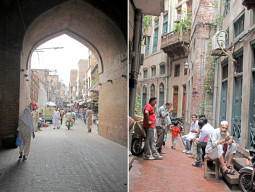
It is often said that ‘Karachi has many owners,’ a reference to the many agencies that claim ownership of land in Karachi. A defining characteristic of land ownership and development in Karachi that impacts all aspects of policy making, planning and development and regulation is the extremely high percentage of government ownership.

Nearly 90 per cent of Karachi’s land is under public ownership, where housing facilities cannot be extended without the consent of the respective agency. According to the Asian Development Bank’s (ADB) Study of 2005, there are 17 major institutions that are stakeholders in land ownership. While this land is still available for a variety of different uses in relatively central locations, the lack of land made available for housing, particularly low-income housing, has meant that employment centres are mostly located at a significant distance form employees’ housing, and more than half of the city’s population is living in Katchi abadis (squatter settlements). These settlements currently occupy about 40 per cent of city’s residential land area.
Unclear property titles and lack of transparency in transactions are the major impediments in the proper functioning of land markets. It is a complex issue and determining the title to a property is not a straightforward exercise in Karachi. There are multiple documents that can be construed as evidence of ownership, and while this is more of an issue in the settled and urbanised parts of the city, the rural hinterland is now increasingly affected with the increased role of the informal sector in land development and management. The problem of lack of clear property titles in Karachi is a derivative of the multiple landowners, each with its own procedure to record and register ownership.
Forms of land ownership
Three different forms of ownership are employed to formal land market management in Karachi. They are the freehold or outright ownership, leasing and sub-leasing.
Practically all landholding agencies operating in Karachi own land they are administering on a freehold basis. This tradition was initiated by the British administration. Cantonment Boards, the Karachi Port Trust, Karachi Metropolitan Corporation (KMC) and Pakistan Railways were allocated land by the then government on a freehold basis. Land grants were also made during this period to individuals, and these lands are now under private ownership.
The practice was continued by the federal government when Karachi was a ‘federal territory’. Subsequent provincial governments have followed the same practice.
Then there is the ‘leasehold’ system where land holding agencies, after developing the land, execute individual leases of sub-divisions - the lease period traditionally being 99 years. Generally, the lease document contains conditions regarding the typology and allowable functions of the land. However, there are instances of leases being issued by the relevant city authorities that are condition free.
Finally, there is the ‘sub-Lease’ form. This is essentially an agreement between the lessee and a third party, and can contain no condition which is in conflict with the original lease condition. The sub-lease is the most common form of agreement executed between the developer and the individual buyer of the plot, apartment or house. All leases and sub-leases are registered with the registrar’s office, which acts as a representative of the Board of Revenue.
While there is nothing wrong with government agencies owning land, the problem arises when these public sector institutions do not respond or respond slowly and inappropriately to the needs of the population they serve. In Karachi, the inability of the government to effectively meet the residential, commercial and associated demands of a rapidly growing population has meant that supply of land and available stock of commercial and residential land in the market is insufficient. This has pushed up real estate prices and priced out the average homeowner and small business operator from the market. A large amount of land and property is frozen, in the sense that it is neither being developed nor renovated because of inflexible laws, protected tenancies and rent controls.
While it has been difficult to utilise the vacant land in the inner core of the city or initiate vertical expansion, the city has spread outwards, initially managed by the government (KDA schemes) but later through the informal actors and now ‘land grabbers’.
The writer is an urban planner and runs a non-profit organisation based in Karachi city focusing on urban sustainability issues. He can be reached at fanwar@sustainableinitiatives.org.pk
Published in The Express Tribune, September 15th, 2014.




































COMMENTS
Comments are moderated and generally will be posted if they are on-topic and not abusive.
For more information, please see our Comments FAQ